Kerala Plus Two Economics Model Question Paper 1 with Answers
| Board | SCERT |
| Class | Plus Two |
| Subject | Economics |
| Category | Plus Two Previous Year Question Papers |
Time: 2½ Hours
Cool off time : 15 Minutes
General Instructions to candidates
- There is a ‘cool off time’ of 15 minutes in addition to the writing time of 2½ hrs.
- Your are not allowed to write your answers nor to discuss anything with others during the ‘cool off time’.
- Use the ‘cool off time’ to get familiar with the questions and to plan your answers.
- Read questions carefully before you answering.
- All questions are compulsory and only internal choice is allowed.
- When you select a question, all the sub-questions must be answered from the same question itself.
- Calculations, figures and graphs should be shown in the answer sheet itself.
- Malayalam version of the questions is also provided.
- Give equations wherever necessary.
- Electronic devices except non programmable calculators are not allowed in the Examination Hall.
I. Answer all questions from 1 to 14.
Question 1.
The consumer prefer the bundle which has more of at least one of the good and no less of the other good as compared to the other bundle, consumer preference is ………..
a) Indifference preference
b) Monotonic preference
c) Both indifferent and monotonic preference
d) None of the above
Answer:
b) Monotonic preference
Question 2.
Micro Economics is also known in the name of ………..
a) Price Theory
b) Demand Theory
c) Income Theory
d) Cost Theory
Answer:
a) Price Theory
Question 3.
From the following find the open economy multiplier.
![]()
Answer:
c) \(\frac{1}{1-C+m}\)
Question 4.
Identify the demand curve of a monopoly firm

Answer:
b)

Question 5.
Match the coloums A and B. (4 × 1 = 4)
| When r = r max speculative demand for money becomes | > 1 |
| The elasticity of demand curve under perfect competition | 1 |
| The value of marginal propensity to consume when marginal propensity to save is equal to zero | Infinity |
| When nominals GDP is Greater than Real GDP, GDP deflator become | 0 |
Answer:
| When r = r max speculative demand for money becomes | 0 |
| The elasticity of demand curve under perfect competition | Infinity |
| The value of marginal propensity to consume when marginal propensity to save is equal to zero | 1 |
| When nominals GDP is Greater than Real GDP, GDP deflator become | > 1 |
Question 6.
Observe the diagram.
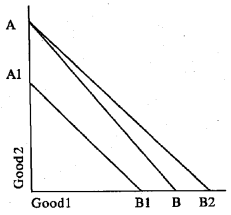
The initial budget line is AB State the reasons for the changes in the Budget line shown below.
a) From AB to A1 B1
b) From AB to AB2
Answer:
a) Consumers income falls
b) Price of commodity 1 falls
Question 7.
Catagorise the following features of market structure into appropriate heads.
a) Differentiated Products
b) Longrun Price = MC
c) Price Takers
d) Homogeneous Products
e) Longrun Price > MC
f) Some Pricing Power
Answer:
Monopolistic Competiton:
a. Differentiated Products
e. Longrun Price > MC
f. Some Pricing Power
Perfect competition:
b. Longrun Price = MC
c. Price Takers
d. Homogeneous Products
Question 8.
Complete the equations
a) GNP = GDP + ………..
b) ……….. = NNPFC + Net indirect Tax
c) Personal Disposable Income = ……….. – (Personal Tax Payment + Non Personal Tax Payments)
d) Gross value added = Gross Value – ………..
Answer:
a) GNP = GDP + NFIA
b) NNPMP = NNPFC + Net Indirect Tax
c) Personal Disposable Income = Personal Income – (Personal Tax Payment + Non Personal Tax Payments)
d) Gross value added = Gross Value – Value of in-termediary goods
Question 9.
If K = 1/2, GDP Deflator (Price level) = 1.5, Real GDP (y) = 1000 crores
a) Write the Equation of Transaction demand for money
b) Calculate the value of it.
Answer:
a) \(\mathrm{M}_{\mathrm{T}}^{\mathrm{d}}\) = Kpy = 1/2 × 1.5 × 1000 = 150
Question 10.
Classify the following into stock and flow
i) National Income
ii) Changes in inventories
iii) Capital
iv) Money Supply
v) Capital formation
vi) Income of household
Answer:
Stock:
iii) Capital
iv) Money Supply
Flow:
i) National Income
ii) Changes in inventories
v) Money Supply
vi) Income of household
Question 11.
A hypothetical Aggregate Demand function is given below.
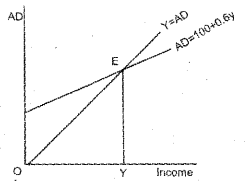
When marginal propensity to consume (c) increased to 0.80, show diagramatically the Changes in equilibrium income.
Answer:

Question 12.
Find outthe equation for
a) Cdr
b) rdr
c) Money Multiplier
d) Transaction demand for money
(CU/DD, \(\frac{1+c d r}{c d r+r d r}\), R/DD,K.T)
Answer:
a) CU/DD
b) R/DD
c) \(\frac{1+c d r}{c d r+r d r}\)
d) K.T
Question 13.
Distinguish the concepts of Ex ante and Ex post
Answer:
Ex ante refers to something that is planned. It is the anticipated. For example investment. Export refers to something that is actually realised. This is actually what has been materialised, e.g. Investment.
Question 14.
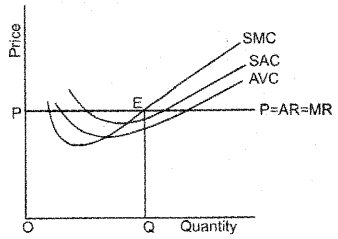
a) Shade the portion of abnormal profit in the above diagram.
Answer:
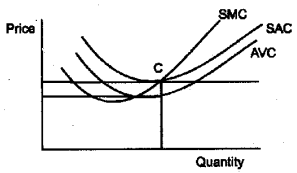
Write any Six Questions from 12 to 21, Each carry diagram.
Question 15.
Catagorise the following under suitable titles.
a) All economic activities in the economy organised by individuals through market.
b) Central authority plans to Allocate Resources.
c) Allocation of resources in the economy decided by market mechanism.
d) Government takes decisions regarding the important economic activities in an economy.
Answer:
Capitalist Economy:
a) All economic activities in the economy organised by individuals through market.
c) Allocation of resources in the economy decided by market mechanism.
Socialist Economy:
b) Central authority plans to Allocate Resources.
d) Government takes decisions regarding the important economic activities in an economy.
Question 16.
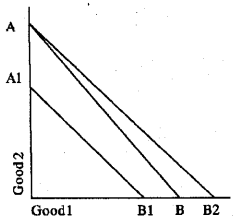
Diagrammatically illustrate the following changes in the above demand curve of Tea.
a) Price of Coffee increases
b) Income of the consumer decreases
c) Price of tea decreases
Total Fixed Cost is Rs. 10
Answer:
a) When price of Coffee increases people will shift to tea. The demand curve of tea will shift rightward.

b) When the income of the consumer falls, the demand for tea decreases, the demand for tea decreases. It shifts towards left.
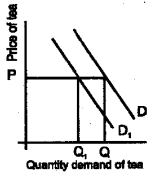
c) When the price of tea falls there is a movement along the demand curve downward from the point to another.

Question 17.

Find TVC, TC and AC and Complete the table
Answer:
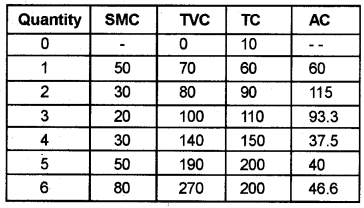
Question 18.
The RBI Changes is monetary policy instruments as follows.
a) Reduction Cash Reserve Ratio (CRR)
b) Increase statutory Liquidity Ratio (SLR)
c) Increase Bank rate
Explain the effect of these policy charges on money supply and Aggregate Demand.
Answer:
a) Money supply and aggregate demand increases.
b) Money supply and aggregate demand decreases.
c) Money supply and aggregate demand decreases.
Question 19.

The diagram shows the equilibrium of the monopolist in terms of the total curves
a) Explain Break even point and mark it on the diagram.
b) Show the maximum profit level of output in the diagram
Answer:
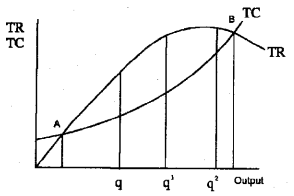
a) Break even point is the point where the TR and TC are equal. A and B in the diagram shows break even point.
b) q1 shows the maximum profit.
Question 20.
The value of GDP at Current price in 2016 is ₹ 5000 crores. The dame GDP evaluated at the price of the year 2010 is ₹ 4000 crores. Using this data.
a) Calculate the GDP Deflator
b) Comment on the changes in the price level
Answer:
a) GDP deflator = \(\frac{G D P}{g d p}\)
GDP = Nominal GDP, gdp = Real GDP
= \(\frac{5000}{4000}\)
= 1.25
b) The price level is increased 25% compared to the previous year.
Question 21.
Explain the components of Aggregate demand in a two sector model economy.
Answer:
In a two sector economy AD = C + I
Where C = consumption, I = Investment. In a two sector economy it is assumed that there are only households and firms in an economy.
Answer any 4 questions from 22 to 27. Each Question carry 5 Score. (4 × 5 = 20)
Question 22.
Suppose a consumer wants to consume two goods. The price of Good 1 is ₹ 10, Price of Good 2 is ₹ 5 and the consumer income is ₹ 30, then
a) Write the budget sets
b) From the budget set which bundles – Cost exactly ₹ 30
c) Derive the Budget Line equation.
Answer:
a) (0,1), (0,2), (0,3)
(1.0), (2,0), (3,0), (4,0), (5,0), (6, 0)
(1.1), (1.2)
(2, 1), (3,1), (4, 1)
(2,2) are the bundles.
b) (0,3), (6,0), (2,2) are the bundles which exactly costs ₹ 30.
c) 10x1 + 5x2 = 30
Question 23.
‘Perfect Competition is a myth and not a reality’ Do you agree with this argument? Substantiate your answer by analysing the features of perfect competition.
Answer:
The features of perfect competition is given below.
- large number of buyers and sellers
- homogeneous product
- free entry and exit
- the firm is a price maker
- perfect information
- no selling cost
Why this market structure cannot exist in the real world is that it is very difficult to have these features suitable for any market structure.
Question 24.
The Price and Revenue Schedule of a monopoly firm is given below
a) Complete the Table
b) Draw AR and MR Curve
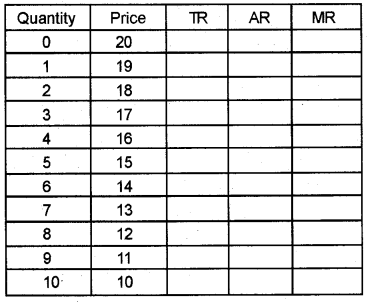
Answer:
a)

b)

Question 25.
Some macro economic variables are given below.
| Item | Rs. (in crores) |
| Depreciation | 200 |
| Final Consumption Expenditure | 2400 |
| Investment Expenditure | 1750 |
| Export | 430 |
| Import | 450 |
| Government Expenditure | 1000 |
| Net Factor Income from Aborad | 600 |
| Net Indirect Tax | 200 |
a) Calculate GDPMP by using expenditure method.
b) Calculate National Income (NNPFC)
Answer:
a) GDPMP = AD = C + I + G + (x – m)
= 2400 + 1750 + 1000 + (430 – 450)
= 5150 + (-20)
= 5150 – 20 = 5130
b) National Income = NNPFC
GNPMP = GDPNP + NFIA
= 5130 + 600 = 5730
NNPMP = GNPMP – Depreciation
= 5730-200 = 5530
NNPFC = NNPMP – Net Indirect Taxes
= 5530 – 200 = 5330
Question 26.
Mr. Shaji is a resident Indian Working in the USA. He decided to purchase the following items when he returns to India. He wants to compare the prices of commodities in the USA and India.
| Item | Price in USA (Dollar) | Price in India (Rs) |
| Shirt | 20 | 500 |
| Laptop | 500 | 30000 |
| Leather Bag | 50 | 2500 |
When Exchange Rate is One dollar = Rs. 50
a) Which Economic Concept will Mr. Shaji use to compare the prices? Write the equation.
b) From which country purchasing these commodities will be more profitable for Mr. Shaji?
Answer:
a) Real Exchange Rate = \(\frac{e p f}{p}\)
b) Shirt = \(\frac{e p f}{p}=\frac{50 \times 20}{500}=\frac{1000}{500}\) = 2 means shirt is expensive in the US.
Laptop = \(\frac{e p f}{p}=\frac{50 \times 500}{3000}=\frac{25000}{3000}\) = 0.53
Means laptop is cheaper in the US, hence better to buy from there.
Leather Belt = \(\frac{e p f}{p}\)
= \(\frac{50 \times 50}{2500}=\frac{2500}{2500}\)
means leather belt costs exactly same in both countries.
Question 27.
The aggregate equilibrium in a simple economy is given below in a diagram.
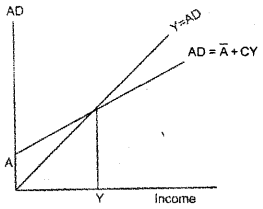
Diagrammatically explain the following changes on the equilibrium income.
a) Government increases the Revenue expenditure
b) Government increases the Lump-Sum Tax
Answer:
When the government increases its revenue expenditure the AD will shift upward. The equilibrium changes from e to e1 The level of revenue increases.
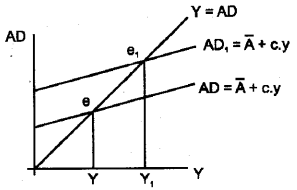
b) When the government increases lumpsum tax the AD shifts downward. Equilibrium changes from e to e1. The level of income falls from y to y1.
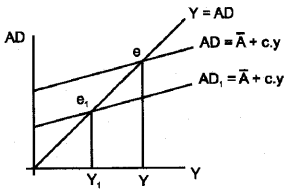
Answer any two Questions from 28 to 30. Each Question Carry 8 marks. (2 × 8 = 16)
Question 28.
a) Explain the concept of market equilibrium with fixed number of firms.
b) Graphically prove how the equilibrium maintain under perfect competition.
c) Show any five changes in the equilibrium price and quantity with the help of diagrams.
Answer:
a) Equilibrium is a situation where the quantity demanded is exactly equal to the quantity supplied.
b) The diagram shows the market equilibrium. D is the demand curve, S is the supply curve. At point e, Qd = Qs. Op is the equilibrium price and Oq is the equilibrium quantity.
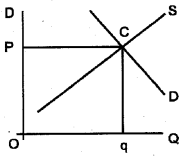
ci) Demand increases, equilibrium changes, price and quantity increases.
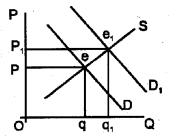
cii) Demand dereases, equilibrium changes, price and quantity comes down.
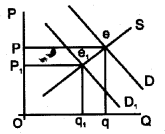
ciii)Supply decreases, equilibrium changes, price increases and quantity comes down.
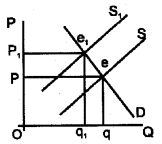
civ)Supply increases, equilibrium changes, price comes down and quantity increases.
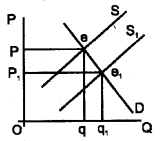
cv) Demand increases and supply decreases, .equilibrium changes, price increases and no change in quantity.
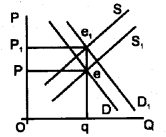
Question 29.
A law says that if we keep increasing the employment of a factor input, other inputs fixed, the marginal product initially rises, after reaching a certain level of employment of input, it starts falling.
a) Identify the law.
b) Diagrammatically explain the Law by using Total Product Curve, Average Product Curve and Marginal Product curve.
c) State the relationships between MP and AP.
Answer:
a) A law of variable proportion
b) The law states that if we keep increasing the employment an input with other inputs fixed initially the total product will rise fast, then will reach a point where the total product starts falling. According to the law the marginal product of an input initially rises and then after a certain level of employment it starts falling.
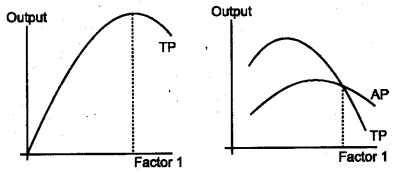
c) Both average and marginal product increases initially. After reaching a certain point both starts falling. The MP will always pass through the maximum point of AP.
Question 30.
a) The Government operates 3 district functions through the budget. Identify and explain these functions of Government.
b) Briefly explain the components of Government Budget.
Answer:
The three functions of Government are
a) i) Allocation function: This function is related to the provision of public and merit goods. The market may not provide them. So the government through budget allocates the provision of these goods.
ii) Distribution function: The government collects high levels of taxes from the rich people and distribute it to the poor sections of the society through subsidies. This is known as distribution function.
iii) Stabilisation function: The government stabilises the economy when there is boon and depression through the aggregate demand. At times of boon government reduces AD and at the time of depression government takes steps to raise AD.
b)

